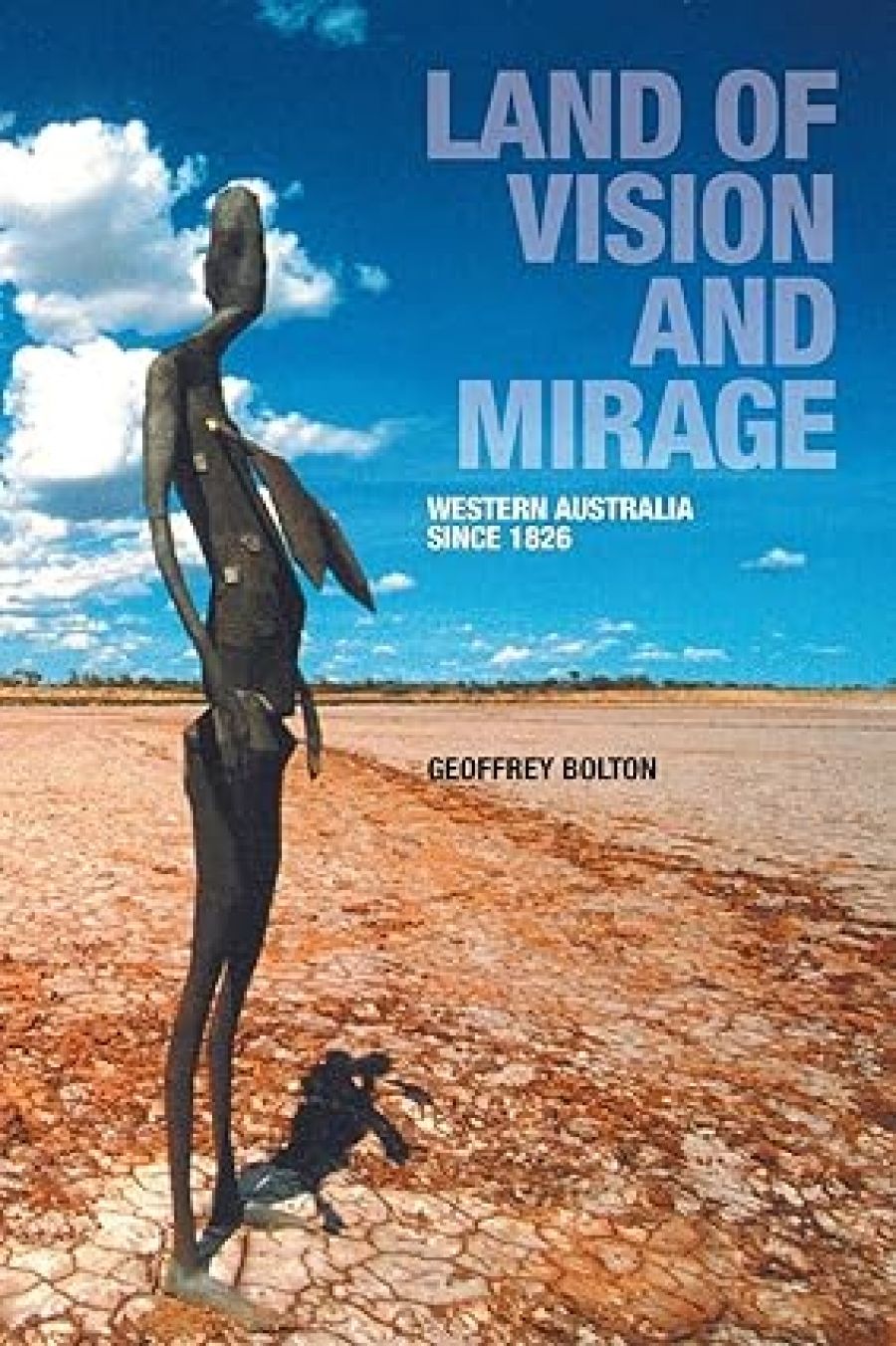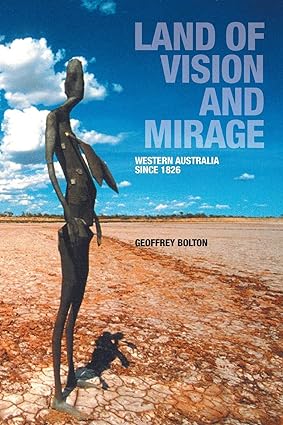
- Free Article: No
- Contents Category: Australian History
- Review Article: Yes
- Article Title: Under the apple tree
- Online Only: No
- Custom Highlight Text:
Scattered across Lake Ballard, a vast salt lake north of Kalgoorlie, are fifty-one androgynous abstracted cast-iron alloy figures created by British artist Antony Gormley in 2002, all based on scans of the inhabitants of a tiny goldfields settlement. Gormley described his figures as ‘strangers in a strange land’. It is not too wild a stretch of the imagination to see them as explorers or prospectors driven by powerful dreams to wander endlessly across a shimmering landscape. One of these figures provides an evocative cover image for Land of Vision and Mirage.
- Book 1 Title: Land of Vision and Mirage
- Book 1 Subtitle: Western Australia since 1826
- Book 1 Biblio: UWAP, $34.95 pb, 270 pp
- Book 1 Cover Small (400 x 600):

- Book 1 Cover (800 x 1200):

Drive west from the goldfields and eight hours later you reach Perth, on the coast. Look west across the Indian Ocean and there, set against the horizon, is the low profile of Rottnest Island. Rottnest is an island of contradictions and transformations; Aboriginal prison, Governor’s summer residence, internment camp, holiday isle. In certain summer conditions, it shimmers and is transformed by mirage into a distant city of skyscrapers, just as the reverse occurs when looking from Rottnest to the coast, as Geoffrey Bolton tells us when he begins his story. Just north of Fremantle, opposite the island mirage, is a huge red dingo emblazoned on a flour mill, a landmark for returning sailors. It is no mirage, but Alan Bond, the young signwriter who famously repainted it, was a mirage-maker.
Vision and mirage are the central metaphors providing the backbone for Bolton’s short history of the vast state of Western Australia. Bond, a convicted fraudster, is just one of a string of entrepreneurial visionaries and mirage-makers who pepper the state’s history.
It began with European settlement. Dutch and French navigators had described the west coast as ‘sterile, forbidding and inhospitable’, but James Stirling, founder of the Swan River Colony, portrayed it as having ‘every attraction that Country in a State of nature can possess’. Thomas Peel, the largest investor in this private venture and, like Stirling, a Scot with a grand vision, brought 450 colonists out with him, but arrived too late to claim his original grant and ended up with an infertile stretch of sandplain south of Fremantle. His settlers were soon destitute and some died. Peel ended up ‘a model of broken-down gentility’. Not all settlers suffered such extremes but, with Bolton’s unfailing eye for a good quote, the reader learns that many settlers – officers on half pay and minor gentry – ‘expect[ed] to have eggs, ham, mutton chops and rump steak in every corner’. Instead for months they ate salt pork and ship’s biscuits, lived in tents and had their sleep disturbed by rats, fleas, flies and mosquitoes, while their despairing servants got drunk. Early settlement led to the introduction of nearly ten thousand convicts, bringing labour, much needed capital, increased imperial authority, a legacy of buildings, roads and other public works, and, as Bolton notes, a lingering miasma of shame.
Not all visions were mirages. John Forrest, Western Australia’s first premier, led the state through the tumultuous goldrush years of the 1890s, steering it from self-government to Federation with visionary purpose and, in Bolton’s assessment, ‘remarkable clarity of policy aims’. One of his outstanding appointments was the engineer C.Y. O’Connor, who, with a remarkable mix of vision and practicality, created a safe harbour for Fremantle, a network of railways and, most spectacularly, a 560-kilometre pipeline which took freshwater from Perth to Kalgoorlie. As Bolton tells us, ‘Nowhere in the world had such a project been attempted on this scale’. The project was a visionary feat of engineering, both for the length of the pipeline and for the eight major pumping stations built along its length to pump the water uphill to the goldfields. O’Connor was unjustly accused of corruption, a Royal Commission was set up to investigate and, in Bolton’s words ‘he committed a dramatic suicide’.
There were others who chased mirages with tragic results. Forrest had trumpeted the value of ‘a bold yeomanary’ who would open up vast tracts of land. Another premier, James Mitchell, established the ill-fated group settlement schemes of the 1920s with heartbreaking consequences. The scheme brought out more than 23,000 British migrants with few agricultural skills, setting them and their families down in heavily timbered bush to create farms on plots of land that had to be cleared, had infertile soil and were too small to be economically viable.
Bolton is well known for his landmark work on the 1930s Depression in Western Australia, A Fine Country to Starve In (1972), which was innovative for its early use of oral history and memorable for his felicitous choice of economist Edward Shann’s words for its title. This forms the basis for a chapter dealing with the interwar years in which Bolton, topically, observes that ‘it is not easy for modern readers in the credit card era, habituated to debt as the price of an education or a roof over their heads, to appreciate how the Depression taught their grandparents frugality and an aversion to risk’.
Research on interwar Western Australia in the late 1980s punctured a hole in Bolton’s earlier claims that Western Australian society was homogeneous in nature and consensual in temperament, and that its reaction to the Depression was therefore muted. Has he modified these claims? Yes and no. He still argues that, until the mid-twentieth century, many Western Australians shared ‘a belief that in their isolated community, disagreements should never be pushed too far, but all should stick together’. Which Western Australians, one might ask. Not those who gathered together to protest in the Treasury Riot of 1931. At the other end of the class divide, there was, as he says, no equivalent of the New Guard in the west. Nevertheless, for several years the Argonauts Industrial Groups, which had been founded to counteract communist influence, looked as if they might become such an organisation. The frustrations of others – businessmen, lawyers and politicians – were channelled into a secession movement that scapegoated the eastern states for tough times. The establishment of the Commonwealth Grants Commission in 1933 helped to moderate the west’s sense of neglect, but in reality the state was saved from the worst of the Depression by gold, and with gold, as later with iron ore and nickel (remember Poseidon?) came more boosters.
One could go on citing individuals – Claude de Bernales, Charles Court, Lang Hancock, Tom Wardle, Alan Bond – who have flourished in the west, but Vision and Mirage is not simply a story of individuals. Bolton shows how the rise of such visionary figures was made possible by the boom–bust economic cycles that have characterised the history of this resource-rich state. Notwithstanding this emphasis on the big end of town, Bolton does not forget the ordinary people who, he hopes, if the title of his last chapter is anything to go by, will live happily ever after.
How then does Bolton’s Land of Vision and Mirage fit into the historiography of Western Australia? We have had long histories – W.B. Kimberly’s and J.S. Battye’s encyclopedias at the turn of the twentieth century, the multi-volume sesquicentary series of 1979, and soon an historical encyclopedia of Western Australia to be published in early 2009 – but short histories? There has only been Frank Crowley’s Australia’s Western Third (1960), ground-breaking at the time, but which I once uncharitably described as ‘a fact-packed narrative’, forgetting that I regularly dived into its index to find those facts. Since Crowley’s day, there has been an immense amount of research into Western Australian history. It has enabled Bolton to flesh out the facts with a myriad of illuminating tales, and to include issues barely touched upon by Crowley, most notably the history of Aboriginal and European contact, the legacy of which is still a running sore.
Manning Clark once advised that a short history should be written as if sitting under an apple tree. Land of Vision and Mirage has this quality. In his book – narrative in style, beautifully written, its major themes illuminated by telling vignettes that draw the reader along, bearing the hallmarks of the social history movement of the 1960s, but grounded in a solid understanding of economic cycles and the great political events of the day – Geoffrey Bolton brings a lifetime’s experience as an historian to the work of crafting this history. Western Australians owe him a great debt.


Comments powered by CComment